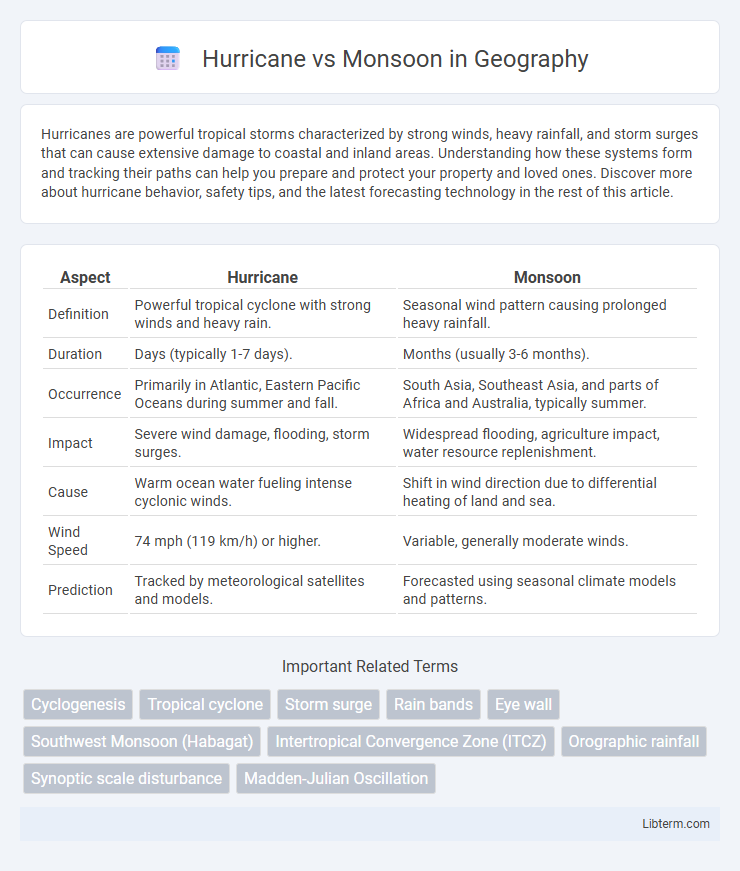Hurricanes are powerful tropical storms characterized by strong winds, heavy rainfall, and storm surges that can cause extensive damage to coastal and inland areas. Understanding how these systems form and tracking their paths can help you prepare and protect your property and loved ones. Discover more about hurricane behavior, safety tips, and the latest forecasting technology in the rest of this article.
Table of Comparison
| Aspect | Hurricane | Monsoon |
|---|---|---|
| Definition | Powerful tropical cyclone with strong winds and heavy rain. | Seasonal wind pattern causing prolonged heavy rainfall. |
| Duration | Days (typically 1-7 days). | Months (usually 3-6 months). |
| Occurrence | Primarily in Atlantic, Eastern Pacific Oceans during summer and fall. | South Asia, Southeast Asia, and parts of Africa and Australia, typically summer. |
| Impact | Severe wind damage, flooding, storm surges. | Widespread flooding, agriculture impact, water resource replenishment. |
| Cause | Warm ocean water fueling intense cyclonic winds. | Shift in wind direction due to differential heating of land and sea. |
| Wind Speed | 74 mph (119 km/h) or higher. | Variable, generally moderate winds. |
| Prediction | Tracked by meteorological satellites and models. | Forecasted using seasonal climate models and patterns. |
Understanding Hurricanes: Definition and Formation
Hurricanes are intense tropical cyclones characterized by low-pressure centers, strong winds exceeding 74 mph, and heavy rainfall. They form over warm ocean waters near the equator, where heat and moisture create powerful thunderstorms that organize into rotating systems due to the Coriolis effect. Unlike monsoons, hurricanes are discrete storm events with defined structures, while monsoons are seasonal wind patterns causing prolonged periods of rainfall.
What is a Monsoon? Key Characteristics
A monsoon is a seasonal wind pattern causing heavy rainfall, primarily affecting South Asia, Southeast Asia, and parts of Africa. Key characteristics include a dramatic shift in wind direction between dry and wet seasons, typically resulting in months of intense precipitation essential for agriculture. Unlike hurricanes, monsoons are gradual, predictable weather systems driven by temperature differences between land and sea.
Origins and Global Locations of Hurricanes
Hurricanes originate over warm tropical ocean waters, primarily in the Atlantic Ocean and the northeastern Pacific Ocean, where sea surface temperatures exceed 26.5degC (80degF). These intense cyclonic storms form near the equator, between 5deg and 20deg latitude, benefiting from the Coriolis effect to develop organized rotation. Monsoons, by contrast, are seasonal wind patterns caused by differential heating between land and ocean, affecting regions such as South Asia, Southeast Asia, and parts of Africa, without forming tropical cyclones like hurricanes.
Monsoon Patterns Around the World
Monsoon patterns around the world are characterized by seasonal wind shifts that bring distinct wet and dry periods, influencing regions such as South Asia, East Africa, and parts of Australia. The South Asian monsoon, driven by differential heating between the land and ocean, delivers up to 80% of annual rainfall to countries like India and Bangladesh during the summer months. In contrast, East African monsoons exhibit a bimodal rainfall pattern contributing to the "long rains" and "short rains," essential for agricultural cycles and water resources in Kenya and Tanzania.
Causes: How Hurricanes and Monsoons Develop
Hurricanes develop from warm ocean waters exceeding 26.5degC (80degF), where moisture-rich air rises, creating low pressure and cyclonic wind patterns driven by the Coriolis effect. Monsoons form from the differential heating between land and sea, causing seasonal wind shifts that bring heavy rains when moist ocean air is drawn toward the warmer landmass. Both phenomena rely on distinct atmospheric and oceanic conditions, with hurricanes originating over tropical oceans and monsoons resulting from large-scale seasonal climate patterns.
Key Differences Between Hurricanes and Monsoons
Hurricanes are intense tropical cyclones characterized by strong winds exceeding 74 mph and a distinct eye, forming over warm ocean waters. Monsoons are seasonal wind patterns that bring prolonged heavy rainfall and influence large geographic regions, particularly in South Asia. Unlike hurricanes, which are short-lived storm systems causing rapid destruction, monsoons result from atmospheric pressure changes and drive extended wet and dry seasons essential for agriculture.
Impacts on Weather and Environment
Hurricanes produce intense winds, heavy rainfall, and storm surges that cause widespread flooding, coastal erosion, and habitat destruction. Monsoons bring seasonal heavy rains essential for agriculture but can also lead to flooding, soil erosion, and landslides in affected regions. Both phenomena significantly alter local weather patterns and impact ecosystems, requiring adaptive management strategies to mitigate environmental damage.
Human and Economic Effects
Hurricanes cause widespread destruction through intense winds and flooding, leading to massive property damage, loss of life, and economic disruption in coastal communities. Monsoons result in seasonal heavy rainfall that can trigger severe flooding and landslides, damaging infrastructure, agricultural productivity, and displacing populations, particularly in South Asia. Both weather events strain emergency resources, disrupt livelihoods, and have long-term impacts on regional economies due to recovery and rebuilding costs.
Preparedness and Safety Tips
Hurricane preparedness involves securing homes with storm shutters, creating an emergency kit with water, food, and medications, and having an evacuation plan due to the rapid onset of high winds and storm surges. Monsoon safety tips include reinforcing drainage systems to prevent flooding, avoiding waterlogged areas to reduce the risk of waterborne diseases and electrocution, and wearing protective clothing to guard against heavy rains and landslides. Understanding the local weather patterns and staying updated with official warnings are crucial for minimizing risks associated with both hurricanes and monsoons.
Future Trends: Climate Change and Storm Patterns
Rising global temperatures intensify both hurricanes and monsoon systems, leading to more frequent and severe storm events. Climate models predict shifts in the intensity and duration of hurricanes, with increased rainfall and stronger winds becoming more common due to warmer ocean waters. Monsoon patterns are expected to become more erratic, with prolonged dry periods interrupted by extreme flooding, driven by altered atmospheric circulation linked to climate change.
Hurricane Infographic

 libterm.com
libterm.com